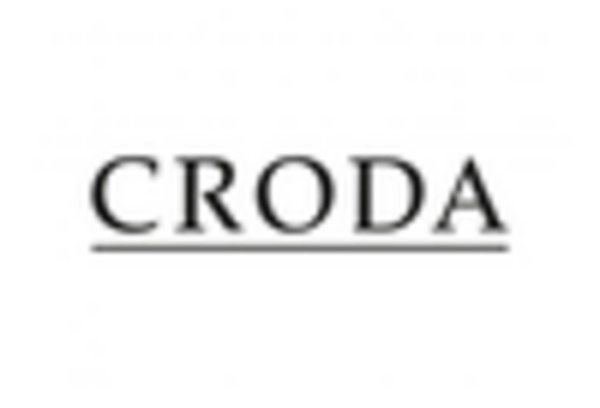Increased Regulatory Scrutiny
The cosmetics personal-care-ingredients market is facing heightened regulatory scrutiny, particularly concerning ingredient safety and labeling practices. Regulatory bodies are implementing stricter guidelines to ensure consumer safety, which is compelling manufacturers to reformulate products and disclose ingredient sourcing. For instance, the FDA has been actively reviewing the safety of certain chemicals commonly used in cosmetics, leading to increased compliance costs for companies. This regulatory environment is likely to drive innovation in safer ingredient alternatives, thereby reshaping the landscape of the cosmetics personal-care-ingredients market. Companies that proactively adapt to these regulations may gain a competitive edge by positioning themselves as leaders in safety and transparency.
Growing Demand for Natural Ingredients
There is a notable shift towards natural and organic ingredients in the cosmetics personal-care-ingredients market. Consumers are increasingly seeking products that are free from synthetic chemicals, which has led to a surge in demand for plant-based and sustainably sourced components. According to recent data, the market for natural personal care products is projected to grow at a CAGR of approximately 8% over the next five years. This trend is driven by heightened awareness of the potential health risks associated with synthetic additives, prompting manufacturers to reformulate their products. As a result, the cosmetics personal-care-ingredients market is adapting to meet these consumer preferences, resulting in an expansion of product lines that emphasize transparency and eco-friendliness.
Rise of Personalization in Beauty Products
Personalization is becoming a key driver in the cosmetics personal-care-ingredients market, as consumers increasingly desire products tailored to their individual needs. This trend is reflected in the growing popularity of customizable skincare and haircare solutions, which allow consumers to select ingredients based on their specific skin types and concerns. Market Research Future indicates that personalized beauty products could account for up to 20% of the overall cosmetics market by 2026. This shift towards personalization not only enhances customer satisfaction but also encourages brands to innovate and diversify their ingredient offerings, thereby influencing the overall dynamics of the cosmetics personal-care-ingredients market.
Sustainability and Eco-Conscious Consumerism
Sustainability is emerging as a critical driver in the cosmetics personal-care-ingredients market, as consumers increasingly prioritize eco-friendly products. The demand for sustainable packaging and ethically sourced ingredients is reshaping product development strategies. Recent surveys indicate that over 60% of consumers are willing to pay a premium for products that are environmentally friendly. This shift is prompting brands to adopt sustainable practices, such as reducing plastic waste and utilizing biodegradable materials. Consequently, the cosmetics personal-care-ingredients market is witnessing a transformation, with companies that embrace sustainability likely to attract a loyal customer base and enhance their market position.
Influence of Social Media and Digital Marketing
Social media platforms are playing a pivotal role in shaping consumer preferences within the cosmetics personal-care-ingredients market. Influencers and beauty bloggers are increasingly promoting products that highlight unique ingredients, often leading to viral trends. This digital marketing approach not only enhances brand visibility but also educates consumers about the benefits of specific ingredients. As a result, brands are investing heavily in social media campaigns to engage with their audience and showcase their ingredient transparency. The impact of social media on purchasing decisions is profound, with studies indicating that nearly 70% of consumers are influenced by online reviews and recommendations. This trend is likely to continue driving growth in the cosmetics personal-care-ingredients market.

















Leave a Comment